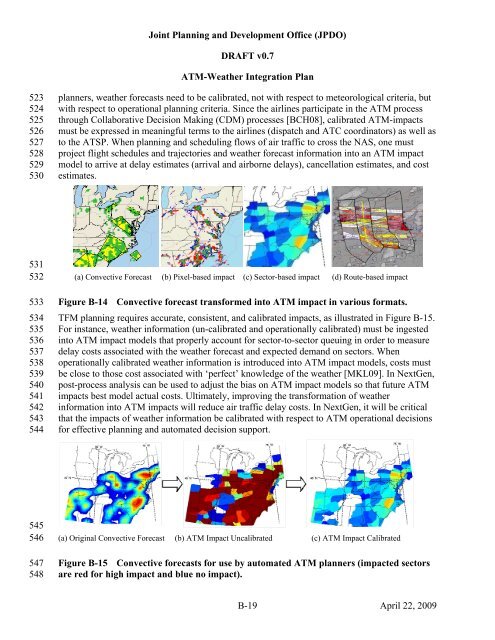ATM-Weather Integration Plan - Joint Planning and Development ...
ATM-Weather Integration Plan - Joint Planning and Development ...
ATM-Weather Integration Plan - Joint Planning and Development ...
Create successful ePaper yourself
Turn your PDF publications into a flip-book with our unique Google optimized e-Paper software.
<strong>Joint</strong> <strong>Plan</strong>ning <strong>and</strong> <strong>Development</strong> Office (JPDO)<br />
DRAFT v0.7<br />
<strong>ATM</strong>-<strong>Weather</strong> <strong>Integration</strong> <strong>Plan</strong><br />
523<br />
524<br />
525<br />
526<br />
527<br />
528<br />
529<br />
530<br />
planners, weather forecasts need to be calibrated, not with respect to meteorological criteria, but<br />
with respect to operational planning criteria. Since the airlines participate in the <strong>ATM</strong> process<br />
through Collaborative Decision Making (CDM) processes [BCH08], calibrated <strong>ATM</strong>-impacts<br />
must be expressed in meaningful terms to the airlines (dispatch <strong>and</strong> ATC coordinators) as well as<br />
to the ATSP. When planning <strong>and</strong> scheduling flows of air traffic to cross the NAS, one must<br />
project flight schedules <strong>and</strong> trajectories <strong>and</strong> weather forecast information into an <strong>ATM</strong> impact<br />
model to arrive at delay estimates (arrival <strong>and</strong> airborne delays), cancellation estimates, <strong>and</strong> cost<br />
estimates.<br />
531<br />
532<br />
533<br />
534<br />
535<br />
536<br />
537<br />
538<br />
539<br />
540<br />
541<br />
542<br />
543<br />
544<br />
(a) Convective Forecast (b) Pixel-based impact (c) Sector-based impact (d) Route-based impact<br />
Figure B-14 Convective forecast transformed into <strong>ATM</strong> impact in various formats.<br />
TFM planning requires accurate, consistent, <strong>and</strong> calibrated impacts, as illustrated in Figure B-15.<br />
For instance, weather information (un-calibrated <strong>and</strong> operationally calibrated) must be ingested<br />
into <strong>ATM</strong> impact models that properly account for sector-to-sector queuing in order to measure<br />
delay costs associated with the weather forecast <strong>and</strong> expected dem<strong>and</strong> on sectors. When<br />
operationally calibrated weather information is introduced into <strong>ATM</strong> impact models, costs must<br />
be close to those cost associated with ‘perfect’ knowledge of the weather [MKL09]. In NextGen,<br />
post-process analysis can be used to adjust the bias on <strong>ATM</strong> impact models so that future <strong>ATM</strong><br />
impacts best model actual costs. Ultimately, improving the transformation of weather<br />
information into <strong>ATM</strong> impacts will reduce air traffic delay costs. In NextGen, it will be critical<br />
that the impacts of weather information be calibrated with respect to <strong>ATM</strong> operational decisions<br />
for effective planning <strong>and</strong> automated decision support.<br />
545<br />
546<br />
547<br />
548<br />
(a) Original Convective Forecast (b) <strong>ATM</strong> Impact Uncalibrated (c) <strong>ATM</strong> Impact Calibrated<br />
Figure B-15 Convective forecasts for use by automated <strong>ATM</strong> planners (impacted sectors<br />
are red for high impact <strong>and</strong> blue no impact).<br />
B-19 April 22, 2009

















